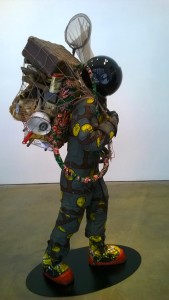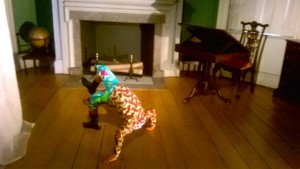By Kemi Osukoya
May 2015
I don’t think I ever thought I’d see the Greek gods – Zeus, Apollo and Poseidon – embodied as little girls, wearing ballerina tutus made from an African batik textiles, but then again weirder things have happened when it comes to art, especially when it is being delivered by British-Nigerian conceptual artist Yinka Shonibare, MBE.
This time as he explores the paradoxical issues concerning enlightenment through the lens of climate change and human instinct for survival against extreme climate, and colonialism in his latest two New York city exhibitions, “Rage of the Ballet Gods,” now on view through June 20 at the James Cohan Gallery, which runs concurrently with “Yinka Shonibare MBE: Colonial Arrangements” at Morris-Jumel Manson.
“Rage of the Ballet Gods,” though a new kind of work, it isn’t a far departure from Shonibare’s customary explorations of contemporary political and social conditions using historical events as metaphors. What’s new about the latest show at the James Cohan Gallery is that it’s designed as visual avatar that connects the eccentric divide between the physical and intangible world, which is probably most clear in “Refuge Astronaut, 2015,” Shonibare’s climactic piece of the show.
In this piece, Shonibare took inspiration from human space exploration. The mannequin, dressed in astronaut suit made from African textile, carries a backpack made out of a fishnet- the backpack contains empty cases of essential housewares including a suitcase, a pot and a picnic baskets and a can waterbottle – and is seemingly looking for a new planet to reside. Shonibare deliberately uses objects he collected on eBay, all packed into a backpack made out of a fishing net, as a nod to the fact that nestled within the traditional ecosystem of art and life are an amalgamation of ideas and concepts that are quite strange yet fascinating and unnatural. While at the same time pointing to the fact that so much of the materials stuff we collect are junk based on ephemeral experiences. Just because some experiences are fleeting or intangible, as climate change is often described, does that make it more or less valuable? And if so, why do we carry those junk, baggage along with us everywhere we go, which ultimately often pollute our new environment?
Of course the issue of climate change is subjective for some people, and this is where it gets tricky, still this show’s sentiment raises an important question: How valuable is something as ephemeral and intangible as climate?
While you take a moment to ponder on that question, why not hop on a NYC subway ride or a Uber cab ride across to uptown to the historical landmark Morris-Jumel Mansion where you will be transported to another era, if not another planet, where enlightenment, in form of colonialism and slavery helped create a new world – America.
Here, Shonibare, using the context of the 18th and 19th Centuries America and the content of house as his backdrop, explores enlightenment through colonialism. His vision represents colonialism in a different light by recreating the eliteness yet contradictory sense of those who inhabited and gathered in the house – the house owners were wealthy, though abhorred slavery, nevertheless used slaves as servants, workers in acquiring their wealth.
The results are wildly unique. On one hand, you see the grandness and elegance of the house interior and you get a sense of the formality of those who lived and gathered there. On the other hand, Shonibare’s art pieces -set against this backdrop and placed sparsely in most rooms in the house- brings to life a rather innocence yet playful way at poking fun at that.
One the first floor, in the parlor, you see something intangible like “The Ghost of Eliza Jumel, 2015” and across the hall in the dining room where a reproduction of a dinner event was created to give the mansion’s visitors an idea of how it would have been done during that era, a boy mannequin, “Planets in My head, Arts 2011,” dressed in mixed African batik and wearing on his head something that looks like a globe, plays a violin, assumedly entertaining the wealthy-gatherers associated with the house as they enjoy their meals.
It’s almost like the ghosts of colonialism and slavery hover the house’s supposedly enlightened people and innocent children. In the upper level of the mansion, Shonibare continues his playful exploration of colonial controversies. Here, a headless mannequin boy playfully cartographs headstand in “Boy Doing Headstand, 2009,” offering an intimate look at the people who lived in the Mansion.
Spearheaded by Carol Ward, the director of Morris Jumel Mansion and James Cohan of the same namesake gallery James Cohan Gallery, the latest New York shows was born of seemingly obvious interests and fascinations with Shonibare’s work.
Ms. Ward was first inspired to bring Shonibare’s work to life at the mansion after she saw his show in 2009 at the Brooklyn Museum and thought it would be a great idea to feature his art at the mansion. Contemplating how to fund her vision, she approached James Cohan, and soon the two became co-conspirators and approached Mr. Shonibare with their idea, not knowing whether or not he would buy into it.
Lucky, Shonibare was intrigued by the story of Eliza and agreed to do the show. When they received the first piece he made for the show, Ms Ward said she was elated.
The show also rightfully commemorate the 250 anniversary of the mansion and its historical importance in American history.
Though it’s meant to be entertaining, Shonibare however has found a way to encapsulate in two nutshells -shows- our past and future, while asking us to use the current window to reflect on both and decide either to learn from our past mistakes and choose to live doing the right things or ignore the past mistakes and continue on the destructive path of destroying the planet Earth, thus destroying our future.
Just like viewing art, whichever answer found will definitely be subjective.
Copyright © 2015 ImeK Media, LLC. All rights reserved.









